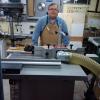
Originally Posted by
Carl Beckett

You know, this brings up an adjacent question: ‘do you often have a ‘finished size’ in mind?
As a hobby worker, I do not. I stop milling once it cleans up or is in a ‘size range’ I want. Again reproducibility isn’t an objective. So if a side panel assembly for example, I don’t reallycare the rail/stile thickness (at least not within about a quarter of an inch). Subsequent pieces will be cut to fit. (And rarely am I building off precise/detailed plans for basic structural fit)
In a production shop this would be Crazy since every joint is custom fit. Depending on build sequence, I could have side panel assys a different thickness than back panel Assy as an example (thickness only impacts interior dimensions)
But it’s related, because there is rarely a need to have a piece with an overly precise size.
Some projects I work like you do and some I bring things to specific dimensions for thickness, etc. What matters the most is "proportion"...that components feel right together, both as subassemblies and for the project as a whole. Actual dimensions don't matter for that and all too often folks get pigeonholed into thinking in terms of "half inch" or "three quarters inch" or "quarter inch" when some other smaller or larger dimension is perfectly fine. Maybe "three eighths" is the right spot or "whatever" is ideal for the project at hand. This very thing is why I'm a fan of things like story sticks and/or having a general dimension in mind and then filling things in with components that are sized exactly from the "framework" of the project, rather than calculated in advance. Honestly, this is the most precise way to work because every component is fitted in the most optimal way relative to other adjacent components. But you are absolutely correct that this isn't the best thing for "production" work because there, repeatability is really important for efficiency and cost control. This is the difference between on-off fine furniture/cabinetry and production work for sure when it comes to building/measuring techniques.
Oh, and being anal about grain and color matching is a good practice in all of this, too. It can be the difference between a very nice project result and an outstanding one.
--
The most expensive tool is the one you buy "cheaply" and often...





 Reply With Quote
Reply With Quote








